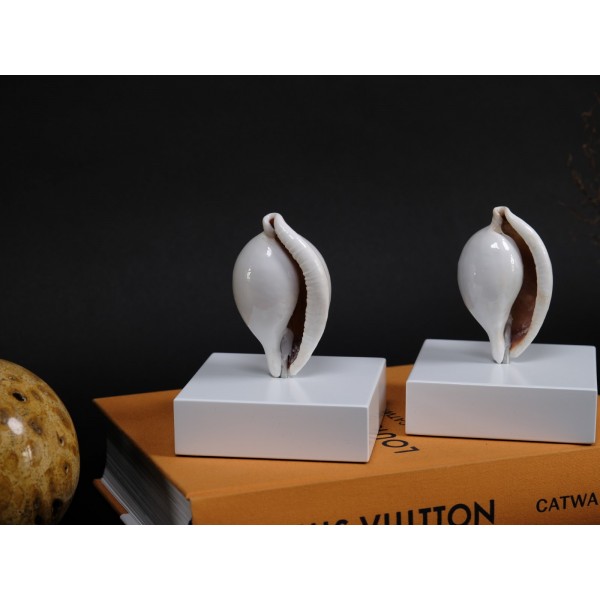Festilyria festiva
A big size perfect Festilyria festiva from Somalia.
A classic rarity, very hard to get in this size and condition, for the serious collector or for decor beautiful shell.
| close |
This shop uses cookies to improve your experience on our website. |
Reference: N722
Pair of Ovula ovum in white lacquered wood base.
A beautiful pure white pair of Ovula ovum dived in Punta Engaño - Philippines. This shell species is from centuries ago as special and many tribes use them as personal adornments.
Dimensions each piece: 12 cm x 10 cm // Base: 10 cm x 10 cm x 3 cm
Weight(both): 609 g

Pair of Ovula ovum in white lacquered wood base.
A beautiful pure white pair of Ovula ovum dived in Punta Engaño - Philippines. This shell species is from centuries ago as special and many tribes use them as personal adornments.
A big size perfect Festilyria festiva from Somalia.
A classic rarity, very hard to get in this size and condition, for the serious collector or for decor beautiful shell.
A huge size, close to 140mm Hexaplex regius from Mexico, showing its beautiful aperture with no defects.
Mounted in a black lacquered wood base.
Syrinx aruanus is the biggest living Gastropod in the world, usually with many scars when it gets bigger.
That makes it very special and rare, with a great quality (F+/ F++),
This one comes from North Western Australia.
Outstanding decor piece in a handmade brass base.
An exceptional specimen of pinna nobilis, from Greece, in a black lacquered wood frame .
The specimen came from a old collection, today is impossible to get this size specimen.
One of a Kind decor piece!
Giant Barrel Sponge (Xestospongia testudinaria) is a giant species of sponge found in the Indo-Pacific coral reefs. It commonly occurs at depths ranging from over 10 meters to 120 meters and can grow up to a diameter of 1.8 meters. The sponge typically exhibits a brownish-red to brownish-gray coloration, with a hard or stony texture. Due to its impressive size and estimated lifespan of hundreds to possibly thousands of years, the giant barrel sponge has earned the nickname "redwood of the reef." It displays a variable form, often appearing as a large, firm, barrel-shaped structure with a cone-shaped cavity at the top called the osculum. These sponges make beautiful decorative pieces. The specimen in question originates from Luzon, Philippines.
Mexican Sunflower Starfish 23 legs and Ophiura from Philippines Glass Dome.
Two very special Echinoderms, both with strange forms that let us see how impressive nature can be. They are high quality specimen in very good colour.
Both of these species are predator of sea urchins.
Mounted by One of a Kind in glass dome with black lacquered base.
Giant Barrel Sponge (Xestospongia testudinaria) is a giant species of sponge found in the Indo-Pacific coral reefs. It commonly occurs at depths ranging from over 10 meters to 120 meters and can grow up to a diameter of 1.8 meters. The sponge typically exhibits a brownish-red to brownish-gray coloration, with a hard or stony texture. Due to its impressive size and estimated lifespan of hundreds to possibly thousands of years, the giant barrel sponge has earned the nickname "redwood of the reef." It displays a variable form, often appearing as a large, firm, barrel-shaped structure with a cone-shaped cavity at the top called the osculum. These sponges make beautiful decorative pieces. The specimen in question originates from Luzon, Philippines.
Beautiful marine composition, looking like big mushrooms, made with shark vertebrae, from Madagascar and Scottish sea urchins, from North sea in a black lacquered wood base.
Cypraea aurantium a classic and iconic shells, very much sough after in the XVII to the middle of the XX century, fetched very high prices, in the 70" was discovered in big numbers in Philippines, still a very desirable collector item for is beauty is now very affordable.
A opportunity to get a beautiful pair from Mactan Isl. - Philippines. Mounted in white lacquered wood bases.
This Elisella specimen in a red flame form is a rare species of gorgonian from Leptogorgia family, found in the coast of Broome, Northwestern Australia.
Gorgons, like corals, are animals living in the form of sessile colonial polyps, organized in a tree structure. The general structure, a skeleton both flexible and hard, called gorgonin does not grow towards the sun - it does not require light to develop -, but perpendicular to the current, to filter a maximum of water flow.
These are beautiful colored specimens!
A colorful marine glass dome displaying an Acropora humilis coral, two Sugar Sea stars, two Alphonso Sea urchins, one purple sea urchin, two white knobbed urchins and two Mithrodia clavigera.
Beautiful decor piece for sea lovers!
Sponge species from Madagascar reefs, mounted in a high gloss beige round lacquered wood base.
Sponges are beautiful decor items, due to its different shapes and colours.
White deep sea marine shells glass dome with beautiful species:
Argonauta argo
Fusinus colus
Xenophora pallidula
Siratus alabaster
Corculum cardissa (2)
Trisidus torquatus
Chama lazarus
Sand dollar urchin (2)
Sea biscuit urchin.
Great natural decor piece!
Four cutted and polished Nautilus pompilius in a glass vitrine with golden lacquered wood base, designed by One of a Kind.
Supplied with certification document.
One of a Kind decor piece!
Nautilus pompilius - nowadays is a protected specimen, this is why it is supplied with CITES.
This is a great chance to get one!
The Big Scottish Sea Urchin, scientifically known as Echinus esculentus, is the largest urchin species found in the UK. This edible species can grow to impressive sizes, making it a standout addition to any collection.
We offer a variety of specimens in different colors, perfect for decorating tables, bowls, and other display areas. Each sea urchin is unique and adds a touch of marine elegance to your home decor.